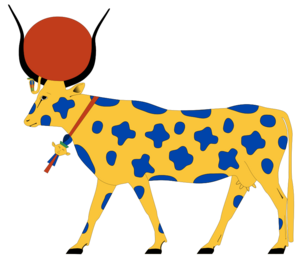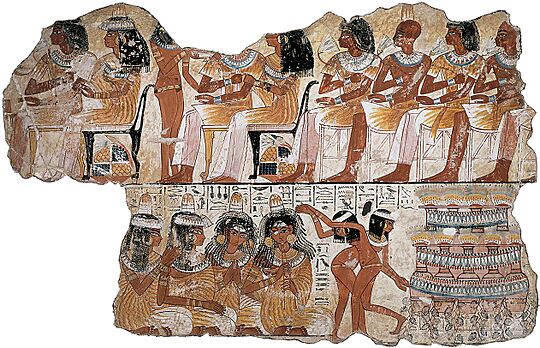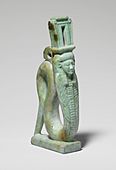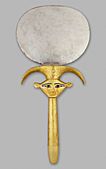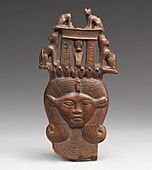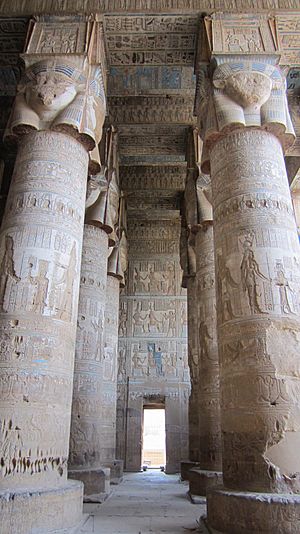Hathor facts for kids
Quick facts for kids Hathor |
|
|---|---|
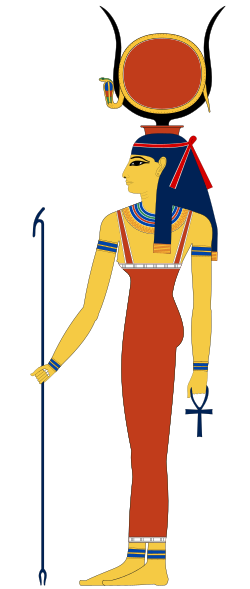
A drawing showing Hathor's most common appearance, based on paintings from the tomb of Queen Nefertari.
|
|
| Major cult center |
|
| Consort | |
| Offspring | Ihy, Neferhotep of Hu, Ra (in a cycle of rebirth), Horus (in some myths) |
| Parents | Ra |
Hathor was one of the most important and popular goddesses in ancient Egyptian religion. She was known for playing many different roles. As a goddess of the sky, she was seen as the mother or wife of the sky god Horus and the sun god Ra. This connected her to Egyptian kings, making her the symbolic mother of the pharaohs.
Hathor had two sides. One was a fierce protector who defended Ra from his enemies as the Eye of Ra. Her other, more gentle side represented joy, music, dance, love, and motherhood. These two sides showed the ancient Egyptian idea of femininity. Hathor was also a guide for souls, helping them travel from the world of the living to the afterlife.
Hathor was often shown as a cow to symbolize her motherly and heavenly nature. Her most common form was a woman wearing a headdress of cow horns with a sun disk between them. She could also appear as a lioness, a cobra, or a sycomore tree.
Goddesses that looked like cows appeared in Egyptian art as early as 4000 BC. However, Hathor became one of Egypt's most important deities during the Old Kingdom (about 2686–2181 BC), with the support of the pharaohs. More temples were built for her than for any other goddess. Her most famous temple is at Dendera in Upper Egypt.
During the New Kingdom (about 1550–1070 BC), other goddesses like Isis became more important in royal beliefs, but Hathor was still widely worshipped by everyone. She continued to be an important goddess until the end of ancient Egyptian religion in the first few centuries AD.
Contents
Origins of the Goddess

Images of cows were common in the art of Predynastic Egypt (before 3100 BC). Cows were seen as symbols of motherhood and nourishment because they provide milk and care for their calves. A very old stone object called the Gerzeh Palette shows a cow's head surrounded by stars. This suggests that from early times, a cow goddess was connected to the sky.
Hathor is first clearly mentioned and shown in art during the Fourth Dynasty (about 2613–2494 BC). She quickly became a very important goddess. She took the place of an older crocodile god at Dendera and became the city's main deity. She also blended with another cow goddess named Bat.
In the Old Kingdom, the sun god Ra was seen as the king of the gods and the father of the pharaoh. Hathor became his mythological wife, which made her the divine mother of the pharaoh.
Roles of Hathor
Hathor had many different forms and roles. Egyptian texts sometimes mention "Seven Hathors," who were seen as different versions of the goddess. Because of her many forms, she represents the wide range of traits that Egyptians associated with goddesses and femininity.
Sky Goddess
Hathor was called the "mistress of the sky" and "mistress of the stars." The ancient Egyptians believed the sky was a great cosmic ocean that the sun god sailed across each day. Hathor was often seen as the cosmic cow who gave birth to the sun god and placed him between her horns.
Her Egyptian name, ḥwt-ḥr, is often translated as "house of Horus." This could mean the sky where the falcon god Horus lived, or it could refer to the goddess's womb, from which the sun was born each day.
Sun Goddess and the Eye of Ra
Hathor was a solar deity and was considered the female version of sun gods like Ra and Horus. She was part of the group of gods who traveled with Ra in his special boat, called a barque, as he sailed across the sky. She was often called the "Golden One" because of the sun's bright light.
She was also one of the goddesses who acted as the Eye of Ra. The Eye was a female version of the sun's power and protected Ra from his enemies. It was often shown as a uraeus (a cobra) or a lioness.
In one famous story, Ra sent Hathor as the Eye of Ra to punish humans who were plotting against him. She transformed into the fierce lioness goddess Sekhmet and became so powerful that Ra worried she would harm everyone. To stop her, Ra ordered a special red-colored drink to be poured all over the land. Sekhmet drank it, thinking it was blood. The drink calmed her down, and she returned to her gentle and joyful form as Hathor.
Goddess of Joy, Music, and Dance
The ancient Egyptians celebrated life with food, drink, music, and dance, which they saw as gifts from the gods. Hathor was closely linked to these celebrations. She was called the mistress of music, dance, flowers, and celebration. In temples, musicians played tambourines, harps, and sistra in her honor.
The sistrum, a special rattle, was very important in her worship. Its sound was thought to bring joy and create new life. These happy celebrations were linked to the myth of the Eye of Ra. Music, dance, and wine were used to calm the fierce goddess and keep her in her joyful form.
Motherhood and Queens
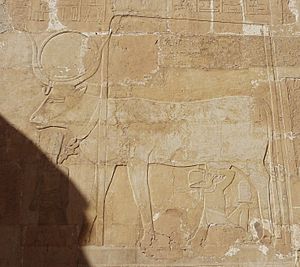
Hathor was seen as the mother of several child gods, including Ihy, the god of music. She was also considered the mother of the god Horus. Because she was the mother of the divine king, she was the heavenly version of human queens.
Images often show Hathor as a cow giving milk to the pharaoh. The milk of a goddess was a symbol of divinity and the right to rule. This showed that the pharaoh was her child and had the gods' blessing to be king.
Hathor's motherly role was different from that of other goddesses like Isis and Mut. While Isis was known for her deep devotion to her husband Osiris, Hathor represented a more free-spirited and joyful kind of love.
Foreign Lands and Trade
Hathor was connected with foreign lands and trade. This might be because as a sky goddess, she was linked to the stars used for navigation. She was believed to protect ships on the Nile River and at sea.
She was especially connected to the Sinai Peninsula, where the Egyptians mined for valuable minerals like copper and turquoise. One of her titles was "Lady of Mefkat" (a word for turquoise). She was also worshipped in Egypt's Eastern Desert at mining sites for amethyst.
Her influence also reached Nubia to the south and the land of Punt on the Red Sea coast. These lands were sources of gold, incense, and other exotic goods, which were seen as gifts from Hathor to the pharaoh.
Guide to the Afterlife
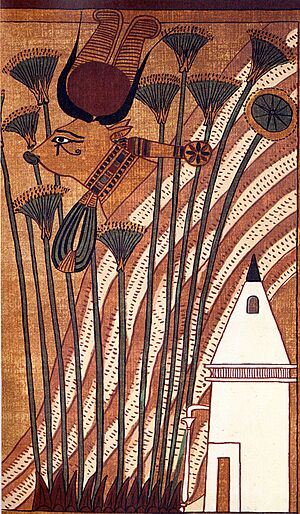
Hathor played an important role in beliefs about the afterlife. She helped the spirits of the dead cross from the world of the living into the Duat, or the realm of the dead. The clusters of tombs on the west bank of the Nile were known as the Theban necropolis, and Hathor was often seen as the goddess of this place. She was sometimes shown as a cow emerging from the western mountains to welcome the deceased.
As a sky goddess, she helped the sun god Ra be reborn every morning. Egyptians believed that dead souls could also be reborn, just like the sun. Tombs and coffins were seen as the womb of the goddess, from which the soul would be reborn into a happy afterlife. Hathor, sometimes in the form of a tree, was shown giving food and water to the souls of the dead to sustain them forever.
How Hathor Was Pictured
Hathor was shown in many ways. She often appeared as a cow with a sun disk between her horns, especially when shown nursing the king. Her most common form was a woman wearing a headdress of cow horns and a sun disk.
Because Isis later adopted the same headdress, the two goddesses can sometimes only be told apart if their names are written next to them. When she was the goddess of the west, she wore the emblem of the west on her head.
Hathor could also be shown as other animals. As a lioness or a cobra, she represented her fierce, protective side. As a domestic cat, she represented her calm and gentle form. When shown as a sycamore tree, her human upper body would often be pictured emerging from the trunk.
Her symbols included the was-sceptre, a staff that was usually only carried by male gods, showing her great power. She also carried a sistrum or wore a special necklace called a menat. Mirrors were another of her symbols, as they were often made of gold or bronze and looked like the sun disk.
-
Amulet of Hathor as a uraeus (cobra) wearing a shrine-shaped headdress, from the early first millennium BC
Worship of the Goddess
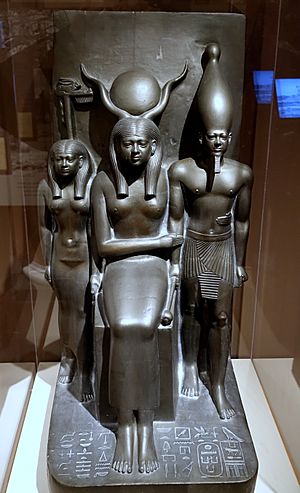
Royal Worship
In the Fourth Dynasty, Hathor became the goddess most closely connected to the king. Pharaohs donated land and resources to her temples. Queens and other royal women often served as her priestesses. Queens in the Middle and New Kingdoms were seen as the living embodiment of Hathor, just as the king was the embodiment of Ra.
Hatshepsut, a woman who ruled as pharaoh, especially emphasized her connection to Hathor to support her right to rule. She built several temples for the goddess, including a chapel in her own famous mortuary temple at Deir el-Bahari.
Temples and Festivals
More temples were dedicated to Hathor than to any other Egyptian goddess. Her main temple was at Dendera, which was built and added to by many kings over centuries. The temple that stands today was mostly built during the Ptolemaic and Roman periods and is one of the best-preserved temples in Egypt.
Many of Hathor's festivals involved music and dancing. One example was the Festival of Joy, which celebrated the return of the Eye of Ra. People celebrated with food and drink to honor life, abundance, and happiness.
Another important event was the Festival of the Beautiful Reunion. During this festival, the statue of Hathor from Dendera was carried by boat to the Temple of Edfu to visit the statue of Horus. This journey symbolized the union of the two gods and the renewal of the cosmos.
Popular Worship
Hathor was not just for royalty. Ordinary Egyptians also worshipped her in their homes and at small shrines. Because having children was very important, people often prayed to Hathor for fertility and safe childbirth.
Hathor was one of the few gods, along with Amun, Ptah, and Thoth, that people prayed to for help with personal problems. They would leave offerings at her temples, such as plaques, figurines, and cloths painted with her image. People also wrote prayers to her on stone tablets called stelae, asking for blessings like plenty of food in life and a good burial after death.
Role in Funerals
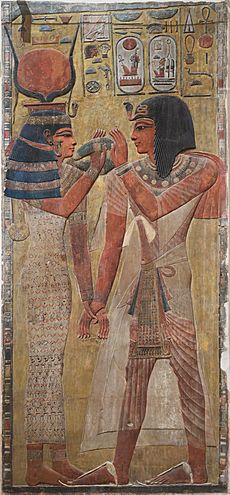
As a goddess of the afterlife, Hathor appeared often in tombs and on coffins. She was frequently shown welcoming the soul of the deceased person into the afterlife. Images in tombs often showed people celebrating with music and dance, which were activities connected to Hathor. These scenes represented the hope that the dead could continue to enjoy life's pleasures in the next world.
The link between Hathor and deceased women was especially strong. In later periods, the names of women who had died were sometimes joined with Hathor's name, just as men's names were joined with Osiris's. This was done to help them be reborn and live forever in the afterlife.
See also
 In Spanish: Hathor para niños
In Spanish: Hathor para niños


